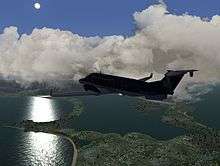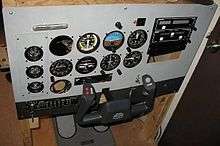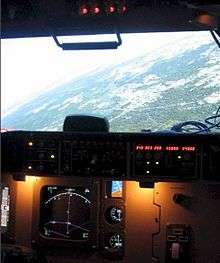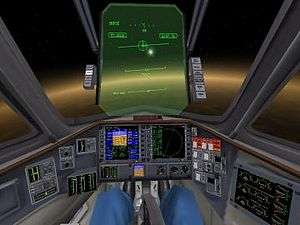Amateur flight simulation
Amateur flight simulation refers to the simulation of various aspects of flight or the flight environment for purposes other than flight training or aircraft development. A significant community of simulation enthusiasts is supported by several commercial software packages, as well as commercial and homebuilt hardware.
 |
| Part of a series on: |
| Simulation video games |
|---|
|
History and use
Prior to the rise of video games, Sega produced Jet Rocket, a first-person electro-mechanical combat flight simulator featuring cockpit controls that could move the player aircraft around a landscape displayed on a screen and shoot missiles onto targets that explode when hit.[1] In 1975, Taito released a simulator video game, Interceptor,[2] which was a crude arcade first-person combat flight simulator that involved using an eight-way joystick to aim with a crosshair and shoot at enemy aircraft that move in formations of two and scale in size depending on their distance to the player.[3]
Flight simulators were among the first types of programs to be developed for early personal computers. Bruce Artwick's subLOGIC simulators were well known for the functionality they managed to get onto 8-bit machines. Key computer game technologies such as 3D graphics, online play, and modding were first showcased in combat flight simulators such as Red Baron II and European Air War. The game world in flight simulators is often based on the real world.[4] However, they are often confined to one part of the game world by invisible boundaries. In some games, the aircraft simply halts in midair, while other games force the player to turn around. However, many games solve this boundary problem by wrapping the game world as a sphere.[4]
Although these games strive for a great deal of realism, they often simplify or abstract certain elements to reach a wider audience. Many modern fighter aircraft have hundreds of controls, and flight simulator games usually simplify these controls drastically. Further, certain maneuvers can knock a pilot unconscious or rip their aircraft apart, but games do not always implement these concerns.[4]
A popular type of flight simulator are combat flight simulators, which simulate combat air operations from the pilot and crew's point of view. Combat flight simulation titles are more numerous than civilian flight simulators due to variety of subject matter available and market demand.

In the early 2000s, even home entertainment flight simulators had become so realistic that after the events of September 11, 2001, some journalists and experts speculated that the hijackers might have gained enough knowledge to steer a passenger airliner from packages such as Microsoft Flight Simulator. Microsoft, while rebutting such criticisms, delayed the release of the 2002 version of its hallmark simulator to delete the World Trade Center from its New York City scenery and even supplied a patch to delete the towers retroactively from earlier versions of the sim.
The advent of flight simulators as home video game entertainment has prompted many users to become "airplane designers" for these systems. As such, they may create both military or commercial airline airplanes, and they may even use names of real life airlines, as long as they don't make profits out of their designs. Many other home flight simulator users create fictional airlines, or virtual versions of real-world airlines, so called virtual airlines. These modifications to a simulation generally add to the simulation's realism and often grant a significantly expanded playing experience, with new situations and content. In some cases, a simulation is taken much further in regards to its features than was envisioned or intended by its original developers. Falcon 4.0 is an example of such modification; "modders" have created whole new warzones, along with the ability to fly hundreds of different aircraft, as opposed to the single original flyable airframe.
One way that users of flight simulation software engage is through the internet. Virtual pilots and virtual air traffic controllers take part in an online flying experience which attempts to simulate real-world aviation to a high degree. There are four networks where this sort of play is possible, the most popular ones being VATSIM and IVAO. The virtual airspace provided by both organizations provides users a low barrier of entry. This allows any member, regardless of skill, the ability to fly without worrying if something goes wrong. The provided airspace on both networks covers the entire globe, VATSIM is generally regarded to have better coverage of North America, Europe, and Australia, while at IVAO pilots and controllers generally fly and control in Africa and South America, in addition to Europe. Both networks receive 600 to 900 ATC and pilot connections daily.
Video game console
Much rarer but still notable are flight simulators available for various game consoles. Successful examples of these are the Pilotwings series by Nintendo and the Ace Combat series by Namco. While generally not as complex as PC based simulators, console flight simulators can still be enjoyable to play, though their 'simulation' status is disputed by many in the flight simulation community.
Homebuilt cockpits

Often referred to as Simpits, home cockpit building is a common hobby among simulator pilots. Simpits range in complexity from a single computer, with some effort to create a permanent area for simulation, through to complete cockpit reconstruction projects utilizing multiple systems. The growth in home cockpit complexity and realism has been further fueled by the opening up of the simulation software packages with published SDKs (Software Development Kits) now common.

The push for higher realism in desktop simulation, often fueled by real pilots looking to practice cheaply at home, has led to a wide array of suppliers growing up to satisfy the demand. Hardware is available from a variety of commercial sources ranging from yokes, throttles and pedals, through to radios, lights and complete instruments. This home use hardware is rarely certified for flight training, so the hours spent practicing in the simpit will not count towards a pilot's hours. However it is widely utilized as an unofficial training aid, allowing realistic procedures practice, as well as the opportunity to complete visual or IMC approaches prior to a real world flight. This can help make a pilot's real-world flight time safer and more productive.[5] Professional opinion is divided about how effective this home simulation can be against real world flight, and this has been a subject of debate in popular flying magazines such as 'Pilot' through 2007.
For those wishing more than a desktop simulator, replica panels are commercially available mimicking those found in a modern airliners such as a Boeing or Airbus. These panels will either fit into a real cockpit section, which some large scale home simulators are built into, or will be mounted in a home constructed cockpit frame, normally made from wood. With most modern airliners now using Glass Cockpit type displays it is relatively simple to replicate the displays in software, outputting them via multi head graphics cards or networked PCs to cheaply available LCD monitors mounted behind the panel. To the casual observer it can be hard to tell a home built static simulator and a commercial one apart.
Where commercial panels or controls do not exist, simulator builders will often create their own out of wood or similar easily worked materials. Another common route for sourcing the specific hardware needed in a simulator, and one used by the commercial sector as well, is to obtain a real component from a scrapyard and convert it for PC input. Interface hardware for these home-made controls is directly available from commercial suppliers, or can be obtained by dismantling cheap joysticks or similar components and rewiring them. Some home builds will even incorporate motion platforms, although unlike commercial simulators these are normally more limited in motion, and often rely on electrical motors as opposed to hydraulics.
Beyond the hardware of home cockpits, most flight simulator software can simulate modern aircraft systems to a very high standard in addition to the basic flight dynamics, providing accurate recreations of, among others, the FMC (Flight Management Computer), autopilot and engine management systems. With additional hardware and add-in software this may be extended further, for example into a fully functional overhead panel requiring real-world check lists to be followed for engine start-up and flight with a full flight deck crew.
Space flight simulators

As space is a natural extension of airspace, space flight simulators may be treated as an extension of flight simulators' genre. There is a considerable interdependence between those two kinds of simulators, as some flight simulators feature spacecraft as an extension and some space flight simulators may feature realistic atmospheric flight simulation engines. For instance, in 2013 a hobbyist space flight simulator project was realized under usage of Pioneer simulation software.[6]
Home software
Popular flight simulators for home computers include:
Flight and space flight simulators
- Microsoft Flight Simulator series, its last installment (Microsoft Flight Simulator X) includes space as an area to be discovered, with a payware Space Shuttle add-on also being available. In 2019, a new installment of the series was announced, Microsoft Flight Simulator 2020 - which is set to release on August 18 2020.
- X-Plane, a realistic simulator developed by Laminar Research since 1993 which also includes a Space Shuttle and Mars flight simulators
- Kerbal Space Program, spacecraft and aircraft construction and flight simulator; initially space-focused, but the addition of air-breathing engines and lift surfaces made atmospheric flight practical
Flight simulators
- Aerofly FS, a modern and realistic simulator with a very performant 3D engine and native support of VR headsets
- Lockheed Martin Prepar3D (P3D), an offshoot of the Microsoft Flight Simulator series built on the engine used in FSX licensed to Lockheed Martin, available both for professional and individual use
- Digital Combat Simulator (DCS), a highly realistic simulator focused on study-level simulations of payware military aircraft. Many aircraft are created using wind tunnel simulations and 3D scanning, giving them a high level of realism and an authentic feel. Capable of single player and online multiplayer combat, native VR support, and high fidelity graphics with PBR materials and lighting. Considered the foremost military flight simulator available to the public-at-large. DCS is also used as the platform for the Fairchild Republic A-10c Thunderbolt II official simulator for the United States Department of Defense, with a simpler, albeit still extremely complex, simulation of the A-10c available for public purchase. Developed by Eagle Dynamics, with many aircraft being developed by third party developers.
- FlightGear, a free and open-source flight simulator, actively maintained by a large user community
- Aerowinx PSX, a Boeing 747 simulator[7]
- Condor: The Competition Soaring Simulator, a sailplane simulator
- GeoFS, a multi-player free flight simulator built on Cesium JS
- IL-2 Sturmovik series, a World War II combat flight simulator
- Rise of Flight: The First Great Air War, a World War I combat flight simulator
- Take on Helicopters, a helicopter simulator developed in 2011 by Bohemia Interactive,
- YS Flight Simulation 2000, a freeware flight simulator
Space flight simulators
- Orbiter, a freeware space flight simulator, also features many types of historical and fictional add-ons
- Microsoft Space Simulator
- Space Shuttle Mission 2007, includes several missions flown by space shuttle
Smartphone flight simulators
- Aerofly FS, also for desktop computers
- Infinite Flight, a flight simulator for iOS, and Android.
- X-Plane 10, a port of the PC simulator of the same name
- Spaceflight Simulator, a rocket simulator by Stef Moroyna.
- Turboprop Flight Simulator, a flight simulator which only includes turboprops
- RFS Real Flight Simulator, a flight simulator developed by RORTOS
Combat flight simulators
Arcade-style
Non-combat
- AeroWings (Dreamcast, PlayStation)
- Bravo Air Race (PlayStation)
- Sky Odyssey (PlayStation 2)
- Pilotwings series (Super NES, Nintendo 64, Nintendo 3DS)
- Radio Helicopter (Wii)
- SimCopter (Windows)
- Wing Island (Wii)
Combat racing
Combat
- AeroWings 2: Airstrike (Dreamcast)
- Master of the Skies: The Red Ace (Windows)
- Red Ace Squadron (Windows)
See also
![]()
References
- Jet Rocket at the Killer List of Videogames
- "Tomohiro Nishikado's biography at his company's web site". Dreams, Inc. Archived from the original on 2009-04-01. Retrieved 2011-03-27.
- Interceptor at the Killer List of Videogames
- Rollings, Andrew; Ernest Adams (2006). Fundamentals of Game Design. Prentice Hall.
- Herd, Andrew (2004-11-09). "Flight Training software". Pilot. Archant Specialist. Archived from the original on 2007-12-19. Retrieved 2007-10-26.
- Amazing dad builds son a spaceship simulator by Michelle Starr on cnet.com (April 11, 2013)
- http://aerowinx.com/
External links
- MiGMan's Flight Sim Museum, video game flight simulators from the 1970s to the present day
- , Linux Air Combat (free, open-source combat flight sim for LINUX)